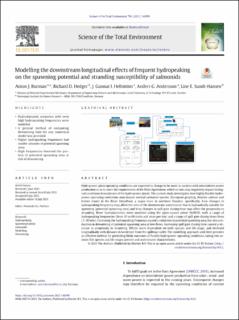| dc.contributor.author | Burman, Anton | |
| dc.contributor.author | Hedger, Richard David | |
| dc.contributor.author | Hellstrom, J Gunnar I | |
| dc.contributor.author | Andersson, Anders G | |
| dc.contributor.author | Sundt-Hansen, Line Elisabeth Breivik | |
| dc.coverage.spatial | Sweden, River Umeälven | en_US |
| dc.date.accessioned | 2022-03-25T08:03:22Z | |
| dc.date.available | 2022-03-25T08:03:22Z | |
| dc.date.created | 2021-07-19T15:12:18Z | |
| dc.date.issued | 2021 | |
| dc.identifier.citation | Science of the Total Environment. 2021, 796 . | en_US |
| dc.identifier.issn | 0048-9697 | |
| dc.identifier.uri | https://hdl.handle.net/11250/2987536 | |
| dc.description.abstract | Hydropower plant operating conditions are expected to change to be more in tandem with intermittent power production so as to meet the requirements of the Paris Agreement, which in turn may negatively impact ecolog- ical conditions downstream of the hydropower plants. The current study investigates how highly flexible hydro- power operating conditions may impact several salmonid species (European grayling, Atlantic salmon and brown trout) in the River Umeälven, a major river in northern Sweden; specifically, how changes in hydropeaking frequency may affect the area of the downstream watercourse that is hydraulically suitable for spawning (potential spawning area) and how changes in spill gate closing time may affect the propensity to stranding. River hydrodynamics were modeled using the open-source solver Delft3D, with a range of hydropeaking frequencies (from 10 to 60 starts and stops per day) and a range of spill gate closing times from (1–30 min). Increasing the hydropeaking frequency caused a reduction in potential spawning area, but also a re- duction in dewatering of potential spawning area at low flows. Increasing spill gate closing time caused a de- crease in propensity to stranding. Effects were dependent on both species and life-stage, and declined longitudinally with distance downstream from the spillway outlet. The modelling approach used here provides an effective method for predicting likely outcomes of flexible hydropower operating conditions, taking into ac- count fish species and life-stages present and watercourse characteristics Hydropeaking Spawning habitat Salmonids Modelling Dewatering | en_US |
| dc.language.iso | eng | en_US |
| dc.rights | Navngivelse 4.0 Internasjonal | * |
| dc.rights.uri | http://creativecommons.org/licenses/by/4.0/deed.no | * |
| dc.subject | Hydropeaking | en_US |
| dc.subject | Spawning habitat | en_US |
| dc.subject | Salmonids | en_US |
| dc.subject | Modelling | en_US |
| dc.subject | Dewatering | en_US |
| dc.title | Modelling the downstream longitudinal effects of frequent hydropeaking on the spawning potential and stranding susceptibility of salmonids | en_US |
| dc.type | Peer reviewed | en_US |
| dc.type | Journal article | en_US |
| dc.description.version | publishedVersion | en_US |
| dc.rights.holder | © 2021 The Authors | en_US |
| dc.subject.nsi | VDP::Matematikk og naturvitenskap: 400 | en_US |
| dc.subject.nsi | VDP::Mathematics and natural scienses: 400 | en_US |
| dc.subject.nsi | VDP::Matematikk og naturvitenskap: 400 | en_US |
| dc.subject.nsi | VDP::Mathematics and natural scienses: 400 | en_US |
| dc.source.pagenumber | 13 | en_US |
| dc.source.volume | 796 | en_US |
| dc.source.journal | Science of the Total Environment | en_US |
| dc.identifier.doi | 10.1016/j.scitotenv.2021.148999 | |
| dc.identifier.cristin | 1922101 | |
| dc.relation.project | EC/H2020/764011 | en_US |
| cristin.ispublished | true | |
| cristin.fulltext | original | |
| cristin.qualitycode | 2 | |

